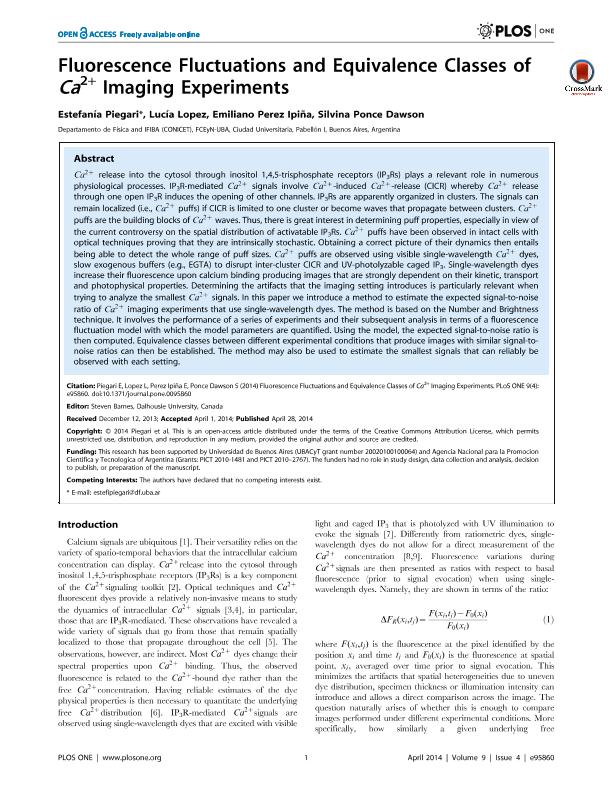Mostrar el registro sencillo del ítem
dc.contributor.author
Piegari, Estefanía

dc.contributor.author
Lopez, Lucía Fernanda

dc.contributor.author
Perez Ipiña, Emiliano

dc.contributor.author
Ponce Dawson, Silvina Martha

dc.date.available
2017-06-09T15:20:09Z
dc.date.issued
2014-04
dc.identifier.citation
Piegari, Estefanía; Lopez, Lucía Fernanda; Perez Ipiña, Emiliano; Ponce Dawson, Silvina Martha; Fluorescence Fluctuations and Equivalence Classes of Ca2+ Imaging Experiments; Public Library Of Science; Plos One; 9; 4; 4-2014; 1-18; e95860
dc.identifier.issn
1932-6203
dc.identifier.uri
http://hdl.handle.net/11336/17866
dc.description.abstract
Ca2z release into the cytosol through inositol 1,4,5-trisphosphate receptors (IP3Rs) plays a relevant role in numerous physiological processes. IP3R-mediated Ca2z signals involve Ca2z-induced Ca2z-release (CICR) whereby Ca2z release through one open IP3R induces the opening of other channels. IP3Rs are apparently organized in clusters. The signals can remain localized (i.e., Ca2z puffs) if CICR is limited to one cluster or become waves that propagate between clusters. Ca2z puffs are the building blocks of Ca2z waves. Thus, there is great interest in determining puff properties, especially in view of the current controversy on the spatial distribution of activatable IP3Rs. Ca2z puffs have been observed in intact cells with optical techniques proving that they are intrinsically stochastic. Obtaining a correct picture of their dynamics then entails being able to detect the whole range of puff sizes. Ca2z puffs are observed using visible single-wavelength Ca2z dyes, slow exogenous buffers (e.g., EGTA) to disrupt inter-cluster CICR and UV-photolyzable caged IP3. Single-wavelength dyes increase their fluorescence upon calcium binding producing images that are strongly dependent on their kinetic, transport and photophysical properties. Determining the artifacts that the imaging setting introduces is particularly relevant when trying to analyze the smallest Ca2z signals. In this paper we introduce a method to estimate the expected signal-to-noise ratio of Ca2z imaging experiments that use single-wavelength dyes. The method is based on the Number and Brightness technique. It involves the performance of a series of experiments and their subsequent analysis in terms of a fluorescence fluctuation model with which the model parameters are quantified. Using the model, the expected signal-to-noise ratio is then computed. Equivalence classes between different experimental conditions that produce images with similar signal-tonoise ratios can then be established. The method may also be used to estimate the smallest signals that can reliably be observed with each setting.
dc.format
application/pdf
dc.language.iso
eng
dc.publisher
Public Library Of Science

dc.rights
info:eu-repo/semantics/openAccess
dc.rights.uri
https://creativecommons.org/licenses/by-nc-sa/2.5/ar/
dc.subject
Calcium Signaling
dc.subject
Fluorescent Dyes
dc.subject
Signal to Noise Ratio
dc.subject
Fluorescence Imaging
dc.subject.classification
Otras Ciencias Físicas

dc.subject.classification
Ciencias Físicas

dc.subject.classification
CIENCIAS NATURALES Y EXACTAS

dc.title
Fluorescence Fluctuations and Equivalence Classes of Ca2+ Imaging Experiments
dc.type
info:eu-repo/semantics/article
dc.type
info:ar-repo/semantics/artículo
dc.type
info:eu-repo/semantics/publishedVersion
dc.date.updated
2017-06-09T14:16:48Z
dc.journal.volume
9
dc.journal.number
4
dc.journal.pagination
1-18; e95860
dc.journal.pais
Estados Unidos

dc.journal.ciudad
San Francisco
dc.description.fil
Fil: Piegari, Estefanía. Consejo Nacional de Investigaciones Científicas y Técnicas. Oficina de Coordinación Administrativa Ciudad Universitaria. Instituto de Física de Buenos Aires. Universidad de Buenos Aires. Facultad de Ciencias Exactas y Naturales. Instituto de Física de Buenos Aires; Argentina
dc.description.fil
Fil: Lopez, Lucía Fernanda. Consejo Nacional de Investigaciones Científicas y Técnicas. Oficina de Coordinación Administrativa Ciudad Universitaria. Instituto de Física de Buenos Aires. Universidad de Buenos Aires. Facultad de Ciencias Exactas y Naturales. Instituto de Física de Buenos Aires; Argentina
dc.description.fil
Fil: Perez Ipiña, Emiliano. Consejo Nacional de Investigaciones Científicas y Técnicas. Oficina de Coordinación Administrativa Ciudad Universitaria. Instituto de Física de Buenos Aires. Universidad de Buenos Aires. Facultad de Ciencias Exactas y Naturales. Instituto de Física de Buenos Aires; Argentina
dc.description.fil
Fil: Ponce Dawson, Silvina Martha. Consejo Nacional de Investigaciones Científicas y Técnicas. Oficina de Coordinación Administrativa Ciudad Universitaria. Instituto de Física de Buenos Aires. Universidad de Buenos Aires. Facultad de Ciencias Exactas y Naturales. Instituto de Física de Buenos Aires; Argentina
dc.journal.title
Plos One

dc.relation.alternativeid
info:eu-repo/semantics/altIdentifier/url/http://journals.plos.org/plosone/article?id=10.1371/journal.pone.0095860
dc.relation.alternativeid
info:eu-repo/semantics/altIdentifier/doi/http://dx.doi.org/10.1371/journal.pone.0095860
Archivos asociados
